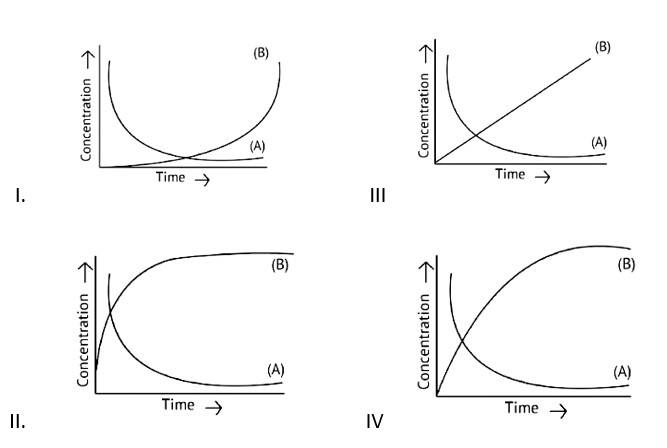Chemical Kinetics
Get insights from 144 questions on Chemical Kinetics, answered by students, alumni, and experts. You may also ask and answer any question you like about Chemical Kinetics
Follow Ask QuestionQuestions
Discussions
Active Users
Followers
New answer posted
4 months agoContributor-Level 10
Initial temperature ; T1 = 300 K
Final temperature ; T2 = 309 K
Rate constant gets doubled i.e K2 = 2K1
New answer posted
5 months agoContributor-Level 10
This is a Fill in the blanks Type Question as classified in NCERT Exemplar
Ans: Correct option B
If A→B then the concentration of both reactants and the products vary exponentially with time. But, in option B graph the reactant concentration decreases exponentially and the product concentration increases.
New answer posted
5 months agoContributor-Level 10
This is a Fill in the blanks Type Question as classified in NCERT Exemplar
Ans: Correct option C
Let's start with what a pseudo-first-order response is.
Although the pseudo-first-order reaction looks to be an order, it belongs to another order. It's a second-order reaction because it involves two reactants.
Let's have a look at a reaction.
CH3Br + OH→CH3OH + Br-
So, the rate law for the reaction is
Rate = k [OH] [CH3Br]
Rate = k [OH- ] [CH3Br] = k (constant) [CH3Br] = K' [CH3Br]
Only the concentration of CH3Br will change during the reaction, and the rate will be determined by the reaction's modifications.
New answer posted
5 months agoContributor-Level 10
This is a Fill in the blanks Type Question as classified in NCERT Exemplar
Correct option C
In the presence of a catalyst, the value of ΔG cannot be changed for any reaction.
ΔG=−RtlnQ
Where Q is the Reaction Quotient, which is determined by the product and reactant concentrations. As a result, ΔG has no connection to the catalyst. Only when the reaction is spontaneous, which must be negative, is it checked. As a result, ΔG cannot be changed.
New answer posted
5 months agoContributor-Level 10
This is a Fill in the blanks Type Question as classified in NCERT Exemplar
Ans: Correct option C
In the presence of a catalyst, the value of ΔG cannot be changed for any reaction.
ΔG=−RtlnQ
Where Q is the Reaction Quotient, which is determined by the product and reactant concentrations. As a result, ΔG has no connection to the catalyst. Only when the reaction is spontaneous, which must be negative, is it checked. As a result, ΔG cannot be changed.
New answer posted
5 months agoContributor-Level 10
This is a Fill in the blanks Type Question as classified in NCERT Exemplar
Ans: Correct option B
Let order of A and B be x and y.
r = k [A]x [B]y
0.1 = k (0.3)x (0.3)y_______1
0.4 = 0.1 = k (0.3)x (0.6)y_______2
0.2 = 0.1 = k (0.6)x (0.3)y______3
Divide 2 by 1
=
Divide 3 by 1
=
Hence Rate law is
r = k [A]1 [B]2
New answer posted
5 months agoContributor-Level 10
This is a Fill in the blanks Type Question as classified in NCERT Exemplar
Ans: Correct option D
Note. It is not possible to perform 100% of the reaction because is half-life
Basically, it is called half-line period of the reaction. So, the time taken for 100% completion of the reaction is infinite.
New answer posted
5 months agoContributor-Level 10
This is a Fill in the blanks Type Question as classified in NCERT Exemplar
Ans: Correct option C
In the case of gases, collision theory is used to predict the speeds of chemical processes. According to this idea, the reacting chemicals must collide with enough energy and in the right direction. The molecules travel quicker and the frequency increases as the temperature rises.
This proves that all three other possibilities, A, B, and D, are correct. Option C does not correspond to the correct answer.
New answer posted
5 months agoContributor-Level 10
This is a Fill in the blanks Type Question as classified in NCERT Exemplar
Ans: Correct option A
The rate concentration of a reaction does not depend upon concentrations of the reactions. Hence, it will remain the same. Even if the equation shows the double concentration level even the rate concentration doubles so it's the same throughout.
Following with the equation
A + 2B→C
If rate considered as (1)
Rate1 = k [A] [B]
If rate considered as 2
Then, Rate1 = k [A] [2B]
Rate2 = 2Rate1
Option A is correct answer
Taking an Exam? Selecting a College?
Get authentic answers from experts, students and alumni that you won't find anywhere else
Sign Up on ShikshaOn Shiksha, get access to
- 65k Colleges
- 1.2k Exams
- 681k Reviews
- 1800k Answers



